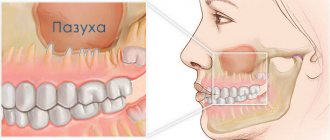Oral papillomas are benign neoplasms in the oral cavity that grow from epithelial cells. Papillomas are discovered during a dental examination and look like separate growing seals on a small stalk, they are painless and have a white or pale pink color.
This type of neoplasm in the oral cavity is diagnosed most often. About 60% of patients are women aged forty years, about 20% are teenagers of any gender. Often, adults experience the appearance of individual papillomas, while children may experience so-called papillomatosis (multiple papillomas). In half of the cases, papillomas are localized on the mucous membrane of the tongue.
Papilloma in the mouth: causes of appearance
The most common cause of this type of tumor is the human papillomavirus (HPV).
Factors that provoke the appearance of papillomas in the oral cavity are, for example, constant microdamage to the cheeks and tongue. A relatively small damage is enough for viral particles to penetrate inside and trigger the formation of papilloma. In children, the provoking factor is a too short frenulum of the tongue - the lower incisors injure it, creating a gateway for infection.
When analyzing papilloma under a microscope, it can be noted that this neoplasm is a tumor, which consists of many layers of epithelial tissue, which in some places has become significantly keratinized. In some areas, traces of the appearance of a focus of inflammatory infection can be noted.
Causes of papilloma
This disease is caused by papilloma, a viral infection that has a long latent, that is, hidden, period. The time during which the disease does not manifest itself after the virus enters the body takes from two months to five years. This is the main danger of such a disease, because in such cases immediate intervention by a surgeon is required, and delay can cause death. The main reason for the formation of papilloma on the gums is a decrease in human immunity.
Classification of oral papillomas
Based on the number and concentration of neoplasms, oral papilloma is differentiated from papillomatosis – a massive accumulation of neoplasms in one place.
According to their origin, papillomas are divided into the following types:
- Traumatic (reactive) papilloma. May appear after traumatic effects of a mechanical, chemical or temperature nature. A distinctive and characteristic feature of reactive type oral papilloma is that their growth stops immediately after the irritant that caused them is eliminated.
- True (neoplastic) papilloma. This type of papilloma begins to develop after the mechanism of cell division, growth, and differentiation is disrupted. In most cases, this type of papillomas appears in the distal part of the cheek, in the area located behind the molars and in the area of the pterygomandibular fold.
- Viral papilloma of the oral cavity. May appear after the patient has been infected with the human papillomavirus. This type of infection occurs through direct contact with a carrier of the virus. When the integrity of the oral mucosa is compromised (for example, due to microtrauma), a path for infection appears.
Benign tumors in the mouth must be removed
Benign tumors of the oral cavity are neoplasms in the oral cavity of a benign nature, which are characterized by limited, slow growth. They can be localized on the mucous membrane of the mouth and lips, as well as in the thickness of the jaws and soft tissues.
The most common tumors are those whose origin is caused by glandular, flat, tooth-forming epithelial tissue, but formations from adipose, muscle tissue, connective tissue structures, blood vessels and nerve trunks are also found.
A person notices changes in the mucous membrane of the oral cavity, inflammation and growths almost immediately. Discomfort intensifies when exposed to hot food or friction with dentures. This could be a papilloma in the mouth - a tumor-like formation on the mucous membrane. It is important to mitigate as much as possible the conditions that predispose to malignant degeneration of the inflamed and overgrown epithelium. By visiting a doctor, you can consult on complex treatment.
The proliferation of epithelial tissue in the oral mucosa is caused by the human papillomavirus (HPV). Its particles are present in the bodies of 9 out of 10 adults on the planet. Some people have no idea about this and do not feel any changes at all. Others have to struggle with the unpleasant manifestations of papillomatosis for many years.
What symptoms of papillomatosis in the mouth should you pay attention to?
Regardless of the specific localization of growths on the oral mucosa, several general characteristics of tumors are distinguished. Usually papillomas on the gums and tongue are pink with a whitish tint, their size does not exceed 10 mm. The most characteristic feature is the presence of a narrow or wide base - the so-called “leg”. The upper part is lumpy, with uneven edges.
Feelings of a person who has become the “owner” of a small tumor in the mouth: it interferes with normal chewing of food and talking. Much depends on the specific location of the papilloma. Typically, the localization of formations is associated with the tongue, gums, lips, and lateral surfaces of the oral cavity. There are not only single papillomas, but also multiple growths. Some are soft and mobile to the touch, others have a keratinized surface.
Before removing growths with such characteristic signs, cytological and histological studies of the material obtained from the mouth must be carried out. Laboratory tests can distinguish papilloma from genital warts or epithelioma and determine the degree of oncogenicity of HPV.
Complex therapy of papilloma in the mouth
Specialists need to clearly limit the growth, identify hidden foci of papilloma in the mouth, the treatment of which is not started without consultation with an oncologist, dentist, or ENT doctor. The choice of therapeutic technique affects the final results, but it is difficult to achieve 100% results.
To increase the effectiveness of treatment, it is carried out comprehensively. According to medical research and patient reviews, this approach reduces the number of relapses, that is, the appearance of new tumors in the oral cavity.
Removal of papillomas in the oral cavity
Treatment of small growths of the mucosal epithelium is fairly quick and almost painless. It is easier to get rid of small round formations on a thin stalk. Typically, oral papilloma has an uneven edge in the shape of a cockscomb or cauliflower. Its color is close to the tone of the mucous membranes, sometimes it is darker or lighter. Removal of such tumors is carried out by deep coagulation with radio waves, evaporation with a laser beam, or traditional surgical excision.
Oral fibroma is a benign neoplasm consisting of fibers of mature connective tissue. It is a clearly demarcated rounded nodule on a stalk or broad base, covered with unchanged mucosa. Characterized by slow exophytic growth. Oral fibroma can be located on the inner surface of the cheeks, mucous membrane of the lips, soft palate, gums, and tongue. Diagnosis of oral fibroma is made by inspection, palpation, ultrasound and histological examination. An orthopantomogram, radiography and periodontogram are used to identify inflammatory processes that provoke the formation of fibroids. Treatment of oral fibroma boils down to its excision. Along with papilloma, lipoma, myoma, nevus and myxoma, fibroma is a benign tumor of the oral cavity. It most often occurs in children aged 6 to 15 years. Clinical dentistry considers traumatic and inflammatory factors to be the causes of the formation of oral fibroma, and a hereditary predisposition can also be traced. Quite often, the history of patients with oral fibroma reveals regular biting of the same area of soft tissue of the oral cavity, which precedes its appearance. Factors that provoke the appearance of fibroma also include trauma to the mucous membrane with a sharp tooth edge, a poorly fixed prosthesis or crown; chronic inflammatory processes of the oral cavity (gingivitis, stomatitis, periodontitis, glossitis, etc.) Signs of oral fibroma Oral fibroma has the appearance of a formation rising above the general surface of the mucous membrane with a wide base or stalk. It is painless, has a hemispherical shape and is covered with a mucous membrane of the usual pink color. The surface of oral fibroma is smooth and, unlike papilloma, has no outgrowths. No changes in the mucous membrane in the area of fibroma are usually observed. In rare cases, ulceration is observed over the tumor. In this case, an infection may occur with the development of inflammatory manifestations: redness, swelling, pain in the area of the fibroma. Oral fibroids typically exhibit a slow increase in size. If the fibroma is not traumatized, its size can remain stable for a long time. With constant trauma, malignant degeneration of the tumor is possible. Diagnosis of oral fibroma The characteristic clinical picture of oral fibroma in most cases allows the dentist to make a diagnosis based on examination and palpation of the formation. To determine the depth of growth of the base of the fibroma into the underlying tissue, ultrasound can be performed. In rare cases, usually when there is ulceration or inflammatory changes in the area of the fibroma, a biopsy of the formation is indicated. More often, histological examination of oral fibroma is carried out after its removal. An important point is the diagnosis of the causative factor in the formation of oral fibroma. For this purpose, a thorough dental examination is carried out aimed at identifying inflammatory diseases of the oral cavity, radiography or radiovisiography, an orthopantomogram and a periodontogram are performed. Patients with dentures need to consult an orthopedic dentist to avoid the traumatic effect of the existing denture on the tissues of the oral cavity. Treatment of oral fibroids The most effective treatment for oral fibroids is surgical excision. Pedicled oral fibroids are removed along with the stem using two bordering incisions. The fibroma at the base is excised together with the base using a bordering or arcuate incision. Removal of fibroma on the red border of the lip is made with an incision perpendicular to the passage of the fibers of the orbicularis oris muscle. For large oral fibroids, to prevent deformation of the mucosa, patch closure of the defect remaining after tumor removal is performed. The flap is cut out using a V-shaped incision from adjacent tissues.
Epulis, popularly called supragingival, refers to benign tumors of the maxillofacial region. Epulis is a tumor-like neoplasm with a diameter of 0.5 to 6-7 centimeters, which is located on the alveolar process of the jaw. The predominant localization of the supragingival is the area of small molars, although in some cases it can occur at the level of any teeth of the upper or lower jaws.
The cause of the occurrence has not been definitively established, but in the vast majority of cases it occurs as a result of prolonged irritation of the mucous membrane of the alveolar process, for example, by the sharp edge of a decayed tooth or from irritation of the mucous membrane by dentures. It occurs quite often in pregnant women; they are often diagnosed with hypertrophic gingivitis. Epulis grows slowly, although pregnant women often experience accelerated growth, apparently caused by hormonal changes in the body. As a rule, patients do not experience any pain, except in cases of injury to the teeth of the opposite jaw. The supragingival partly or completely covers the coronal part of one tooth, and more often than not several teeth at once from the vestibular and sometimes from the lingual surface.
Most often, the tumor has a wide stalk and is covered with ordinary mucosa, without any pathological changes; if the epulis is injured, then areas of erosion and hemorrhage appear. It differs from malignant tumors in that there are no areas of tumor decay. Prolonged growth of the supragingival can lead to destruction of the alveolar process and its spongy substance. In this case, osteoporosis of the bone will be visible on the x-ray.
The color of epulid is slightly different from the color of the oral mucosa - sometimes it has a red-brown or even bluish tint.
Treatment for epulide is only surgical. Considering that epulis has a growth zone in the periosteum and in the bone, after removing the tumor within the visible healthy mucosa, you need to do a thorough curettage around the tumor and remove the softened bone. Sometimes the tooth itself is also removed if it is located in the area of tumor growth and the alveolar process is destroyed by the tumor process. After removal, in some cases, the supragingival tissue may reappear in the same or other areas of the jaws.
Treatment of oral papillomas
Diagnosis of this disease includes a collection of the patient’s medical history, as well as a thorough histological examination of removed papillomas.
Treatment of papillomas is only surgical. The neoplasm is excised down to the borders of healthy tissue. Techniques such as electrocoagulation, cryosurgery, sclerotherapy and others are rarely used, since as a result of their implementation it is impossible to conduct a histological analysis of the papilloma removed to the base.
If a large accumulation of papillomatous neoplasms is detected, a combined technique is used: a scalpel is used to dissect the largest number of papillomas accumulated in one place, and single papillomas are removed using electrocoagulation.
If oral papillomas have a viral etiology, antiviral and immunomodulatory therapy is prescribed along with surgical intervention to prevent relapses.
Depending on the etiology of the disease, relapses may occur with greater or lesser probability. So, if there is a human papillomavirus in the body, the risk of papillomas returning after surgery is quite high.
Laryngeal papilloma
04.06.2021
Most often, papillomas appear in older people and young children, but by the beginning of puberty they tend to disappear. Laryngeal papilloma is a dangerous infectious disease caused by the HPV virus. Single or papillary projections on the vocal cords resemble curly cauliflower in appearance. The danger of the neoplasm is that, despite the fact that papilloma is benign, with complications it can develop into a malignant tumor and block breathing at any time.
Recommendations for the presence of papillomas on the larynx
You cannot remove papillomas on your own. This may lead to the beginning of a new mechanism for their degeneration inside the body, since on our own we cannot find out what the nature of the neoplasms are. The presence of papillomas and warts is the first sign of a malignant tumor !
Symptoms of laryngeal papilloma
At first, a person may not even suspect that he has contracted such a disease, because the disease is hidden and does not manifest itself for a long time. Quite striking symptoms of this disease are hoarseness, leading to loss of voice, roughness and rigidity of the vocal cords, gradual difficulty breathing, and as the tumor increases, it can turn into suffocation, difficult inhalation or exhalation, expectoration of blood , shortness of breath, long cough at night, imperceptible pale or transparent growths on the mucous membrane, small compactions.
Routes of infection
Since laryngeal papilloma is a disease that has signs of an internal nature, you can become infected in three ways, namely:
- During sexual intercourse, petting or oral sex during unprotected intercourse, secretory glands are released. A sick person may not suspect that he is carrying the HPV virus (genital);
- with a handshake, salivation, kiss (contact or airborne);
- During childbirth , the papilloma virus (genital) can be transmitted to the baby in the womb.
Factors influencing the further development of the disease
Without exposure to negative factors, HPV lives in the body from 10 months to 10 years. The following factors can provoke the development of a neoplasm in an infected person:
- frequent allergies ;
- surgery or injury to the larynx;
- poor resistance to stress;
- chronic ENT infections caused by microorganisms or viruses;
- hormonal disbalance;
- bad ecology;
- presence of serious infectious diseases;
- heredity;
- presence of bad habits;
- inappropriate nutrition;
- avitaminosis;
- overweight or underweight.
Laryngeal papilloma can form not only due to the above symptoms, but also due to the presence of parasitic cells inside the body. Why exactly do parasites become the source of many fatal diseases? If warts, papillomas, a large number of moles, pimples , bruises and redness appear on the body, this may be evidence that there are parasites in the body and this person is susceptible to developing dangerous diseases.
Treatment of papilloma on the larynx
The primary and most successful treatment option is surgical removal . But today there are 2 ways to treat the disease: progressive and surgical . They work best together. The progressive technique is used in the early stages and represents the prevention of the body, restoration of the respiratory tract and irradiation of the growth after the introduction of the drug the blood Immunological and antiviral drugs are also prescribed. If the conservative method does not help, then mini-surgeries using the latest endoscopic technologies are used. They are: dissection of high-frequency radio waves, removal with ultrasound , supply of ionized gas to the tissue and complete drying of the papilloma, liquid nitrogen at low temperatures, exposure to current using an electrode. After a successful operation , antibiotics, immunological and vitamin medications are prescribed.
It is important to remember that at the first symptoms you need to urgently visit a doctor , since the disease is secretive and difficult to recognize immediately. Laryngeal papilloma is a benign tumor and the chance of a full recovery is high, the main thing is to consult a doctor and carry out correct and effective treatment.
Published in Otorhinolaryngology, Surgery Premium Clinic










